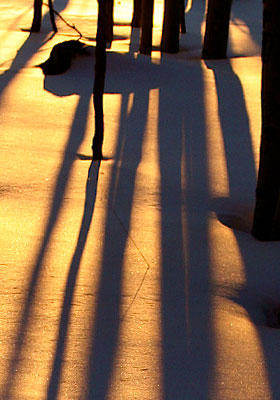Posts Tagged ‘The Beauty Way’
Wednesday, August 12th, 2015

“This world is but a canvas to our imagination.”–Henry David Thoreau
When I traveled in Nepal, Tibet and Bhutan last fall, I was of course struck by the wealth of sacred art. The particular ceiling in this photo was taken in a private home, so these arts are not relegated to skilled monks or to antiquity–they are still practiced by village craftsman. (Granted, in Tibet these craftsmen are an endangered species, since the Chinese are co-opting and controlling everything about Tibetan culture.) Imagine living in a home where your neighbor painted this extraordinary piece of art.
How would looking up at such a ceiling every day affect your vision of the world?
I think sacred arts have been created for many reasons, but one of them must be that the piece of art preserves the vision of the sacred world–and the invisible one–and passes this vision forward, preserving it as part of reality.
When we create any kind of art we are preserving or encoding a view we have of a certain aspect of reality. In that sense, what we saw when we made the piece is what we get as a future.
There’s another sense in which “what you see is what you get.” All the theories that abound today about creating your own reality are based on the idea that our thoughts can become manifest. And our thoughts are largely visual. It’s as though we have a vision–whether it be of ourselves coming down with a cold, or reuniting with a friend–and often we are either grabbing a tissue or answering the phone, delighted at the “coincidence.”
Vision has been proven to affect performance so strongly that most serious athletes visualize that perfect high dive or ski run. Since I’m recuperating from foot surgery and don’t want all the muscles in my left leg to forget they’re muscles, I’m picturing myself dancing, hiking and walking on the sand. Science tells me that my muscles will believe they’re really doing it.
The link between vision and manifestation works from the inside out, and also from the outside in. When I traveled to the Berlin Wall in the ’60’s, I was shocked to see the wall, even though I had studied about Berlin and knew intellectually all about the efforts to divide people from each other. We know there is a big difference between intellectual and emotional knowing. Once I had seen it, I knew I would always be against such walls and would take a stand for what unites rather than divides us. The seeing changed my mind and heart, and became part of me. What I saw was what I got.
So how can you use this notion that what you see is what you get? I can think of three ways:
1. You can purposefully go on treasure hunts for beauty. With your camera or just your physical eyes, you can collect images that will become part of you, in mind, body and spirit.
2. When you see something disturbing, do a re-frame. Instead of focusing just on how disgusting or sad or scary something is, you can ask what the deeper purpose of your seeing could be. That way, you will literally “see” this scene differently, as if you put a filter on your mental camera.
3. You can point out beauty to others. Everyone does not see the subtleties of the pearly light on the foggy mountains. Some people just see grey and “bad weather.” You can always ask if someone sees how many different shades of green there are in the forest. It may literally expand their vision, and thereby their experience.
Beauty is good medicine. If what we see is truly what we get, then I’ll choose beauty any day of the week.
Tags: beauty, consciousness, creative imagination, creativity and empowerment, living today, perception, Photography, spiritual practice, The Beauty Way, Through A Different Lens
Posted in Imagination, shifting how we see, shifting paradigms, spiritual practices, The Beauty Path, Tools for seeing ourselves | 5 Comments »
Thursday, July 9th, 2015
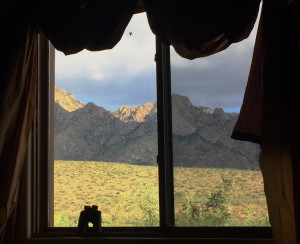
My Window on the World
I’m writing you from my bed. I’ve been here a good deal since my surgery six days ago. I do get around on my scooter walker, and also have a wheel chair we used today for my first post-op visit to the doctor. Things are going well on the whole–and this land out the window is an important spot for the healing I still have ahead.
The Sutherland Valley where I live is a beautiful, unspoiled place on the edge of the wild, and has been my healing sanctuary ever since we moved here 14 years ago. Then, I was in the middle of chemo treatment for my first round of breast cancer. These mountains and this land have been a comfort and source of beauty and inspiration for what seems like too many physical challenges.
And yet, I keep recovering, keep learning, keep being inspired, keep finding that life still holds magic and mystery and unanswered questions and unexplored territory that compels me to answer a call.
The view out the window beckons me to enter the majesty of life, even when I am trapped in pain or limitations. Look at all there is! The endless, ever-changing play of light, the land moving from parched to green and back. The line of shadow that seems to be an impassible boundary but is not. Shadow and light. Beauty.
Beauty is my medicine, and I am graced with it all around me. Even in this season that I’ve always proclaimed to hate I find wonders.
So I will write to you from here, musing about the view outside this window, showing you some of its moods, and sharing some of mine. I’m not sure what to expect on this next journey of healing, but I’m on it. Committed. On the way. What will be revealed–in the landscape, in my own nature? How will my foot and the rest of my being respond to this surgery? How will I begin to walk when the time comes?
It is way too soon to know. This is a time for quiet. For being, not doing. For resting, not working. And yet writing is part of my solace and my reaching outside these four walls for contact, for dialogue.
Questions for you to ponder:
- What do you do and how do you respond when you are sequestered and limited?
- What is your part in the journey of healing? How do you work with your body? Your emotions?
- How does the land around you participate in your process? Do you feel energy from the mountains, or water sources or land features nearby?
- How do you make larger meaning out of an illness or surgical procedure, even if chosen? How do you turn it into an opportunity?
These are questions I’ll be pondering in coming weeks. Let me know your thoughts!
Tags: Being, healing, perception, The Beauty Way, transitions, ups and downs
Posted in Uncategorized | 8 Comments »
Saturday, January 10th, 2015

As I weep over the multi-layered tragedy in France, I am also aware of pain in other areas, both personal and institutional, all around us. The pain raises that age-old question once again, a question that is more dramatic than ever in this age where we are exposed to global events in the media in a very tangible way. What is our role when we see suffering, and how do we handle our feelings about it?
When I move away from the huge issues surrounding terrorism, religious intolerance and violent fundamentalism and concentrate on my own life, certain themes become clear. Some examples…
Clients always come to me with a story, and I come to myself with my own stories. All of us want these stories solved, and we usually approach them by trying to figure them out. When we get engaged on that level, we usually get caught in a loop, going round and round. I tell my clients and myself, “The answer does not lie within the story.”
My shamanic training taught me to be an ally for clients by looking at their story “through a different lens.” Instead of engaging with the drama, my job is to hold space for a larger possibility.
The story has brought the client to a crossroads, where there is a decision to be made. Do I take the same road I’ve always taken when issues like this come up, or do I take a road I’ve never taken?
I ask them to choose the road not taken, which is to engage not from the “smaller” self that becomes victim to every drama, but from the larger self which knows better. This self can look at things from a larger consciousness, from the soul level. From that level, there is a big, long journey visible.
And so the larger self can say about the current tragedy, “Of course you have these emotions about it.” And then that soul-self can add, “And what could be good about all this?
On a personal level, what could be good about a tragedy is that someone might respond to it by deciding to go down the road of truly seizing their life and going after their heart’s desire. Now there’s an exciting opportunity!
On an institutional level, when things fall apart, the good thing could be that the leadership sees old patterns that are not sustainable and embraces a larger vision that really serves their dream and also serves the planet. Hooray!
And on a global level, the good thing about a terrible tragedy is that it brings things to light that have not been recognized by the general populace, and they have the chance when they see what’s wrong, to stand for a new and brighter road to a different future.
The crossroads in all three situations present the choice between submitting to something that may feel like fate, or seizing our soul’s true destiny. I would like to hold the vision of that destiny, and to take a stand for that.
I do that through spiritual practice that reminds me of who I truly am and of my unity with unseen spiritual support. And I hold energetic space for change to flow through me and through others, who will make their own choices.
This is a tough discipline for sure. But that is what we are being asked to do, and why we may be on the planet at this time. So join me in responding to it all with–along with our natural grief and compassion–a larger and more powerful force that holds it all.
Tags: consciousness, creativity and empowerment, living today, managing change, meditation, non-attachment, perception, spiritual practice, The Beauty Way, transitions
Posted in conscious evolution, consciousness, managing change, meditation, overcoming fear, self-healing, shifting how we see, shifting paradigms, spiritual practices, Tools for seeing ourselves | 2 Comments »
Tuesday, December 2nd, 2014

I had the privilege of traveling to the little kingdom of Bhutan recently, and one of the many gifts I received from that visit was the inspiration to spread the word about GNH. For Bhutan’s policy-making is guided not by the GNP (Gross National Product) but by GNH–Gross National Happiness.
It’s more than just a cute-sounding idea. There are documents outlining the four pillars, nine domains, and metrics for weighing and measuring progress. (http://www.grossnationalhappiness.com/) This little country of only 750,000 people is a model for a self-chosen set of values based on something we all chase: no, it’s not money; it’s happiness!
Thanks to our trip organizer, Narayan Shrestha (founder of the non-profit, Helping Hands), we were privileged to have a private dinner with the mayor of Thimpu, the national capital. Kinlay Dorjee seems humble, sincere, and clearly devoted to increasing the GNH in the capital and throughout the country. He spent some time introducing us to the four pillars, which are:
1. Good governance
2. Equitable and sustainable socio-economic development
3. Preservation and promotion of cultural heritage
4. Preservation and promotion of the environment
Pretty wonderful measures for policy-making, right? Let me backtrack to the inspiring back story.
In the 1970’s His Majesty the Fourth King Jigme Singye Wangchuck observed that economic growth had become the measure of growth and success across the world and at both collective and personal levels. Given the costs we are paying for this ideology, this enlightened king decided he would focus on a different set of values.
He came up with GNH, based on the belief that collective happiness of a society is the ultimate goal of governance. His legacy to his son, the current fifth King Jigme Kheser Namgyel Wangchuck, was the job of creating an operational framework for the growth of GNH in his country.
Finding that the four pillars were not complete enough, the Royal Government of Bhutan initiated the Good Government Plus (GG+) in 2005. Then the Centre for Bhutan Studies and GNH Research worked on indicators that now classify the values into nine domains. They are:
- Psychological wellbeing
- Health
- Education
- Time use
- Cultural diversity and resilience
- Community vitality
- Good governance
- Ecology
- Living standards
Can you imagine a day when your government might ask if these nine domains are being addressed before deciding on a policy? For example, what if deciding on a policy for immigration involved asking, “What policy will increase cultural diversity and resilience?”
Can you imagine a day when corporate boards and executives might ask themselves how happy they and their employees and customers are, using these nine domains? How are corporate policies affecting the health domain, for instance?
And can you imagine a day when you might ask yourself if the decisions you’re making in your own life are taking these nine domains into consideration? Is that decision you’re considering going to affect the ecology of the planet? Your relationship to ecology will actually affect your happiness.
Some evidence I saw that these measures are working in Bhutan: the clean, sparkling rivers, which were like something out of a dream. Plastic bags are illegal; stores give out fiber bags. Tobacco is illegal and you cannot bring it into the country. People wear traditional dress–the men wear elegant robes over dark or argyle socks and dark shoes. The women wear lovely long skirts topped by jackets with a shawl collar often in a contrasting color. There is only a small military presence. Buddhist temples and other historical and cultural sites are beautifully preserved, and prayer flags fly everywhere there is a holy site or particularly stunning view.
Of course the country still faces challenges. But I was struck by the spiritual underpinning or energy, if you will, that was palpable everywhere. I felt an air of kindness, an atmosphere of reflection, an attitude of appreciation. This doesn’t stem from isolation; even monks were talking on cell phones. But it felt as if people had it straight that technology was not the end point. What they’re after is working with nature and with our own gifts, promoting what every human longs for: happiness.
Tags: Bhutan, consciousness, creativity and empowerment, Gross National Happiness, inner peace, living today, managing change, The Beauty Way
Posted in caring for the earth, conscious evolution, consciousness, creativity and empowerment, happiness, loving ourselves, managing change, new life, nourishing ourselves, policy making, shifting how we see, shifting paradigms, The Beauty Path | 7 Comments »
Tuesday, March 12th, 2013
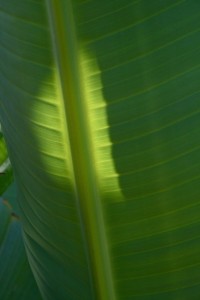
Most people approach photography in a documentary way photographing an event, a person or an object in order to remember it, or to say, “This is how it is.” We tell a story of what we see. But another way to approach photography is through the question, “What have I not seen?”
Now we’re on a treasure hunt! And rather than thinking of “shooting” something with the camera (or phone,) we might think of opening the lens to something new. Just writing that opens my heart to the possibility of a magic moment where I might discover…anything.
Instead of “capturing” a moment, I’m willing to be more passive and let something new present itself to me. It’s the difference between a reporter covering an event and two friends of lovers having an intimate conversation. I’m open today to having a heart-to-heart with the Creation.
This kind of experience opens our inner eye. We find that what was formerly unseen was there all along, but we weren’t seeing it. Maybe we weren’t slowing down enough. Or maybe we weren’t broadening our vision. Or getting close enough. Or maybe we were being too literal and saying to ourselves, “There’s a leaf.” Instead of looking at that object as a way for us to see how light acts.
And what happens when our inner eye is opened? Well, my experience is usually gratitude. Appreciation. That wonderful expansive feeling that comes from being opened to the beauty of something or someone.
So here’s an assignment for you:
Go out for a medicine walk using your camera. The kind of camera makes no difference. Set your intention by asking the Universe to reveal to you something you haven’t seen before. It could be small–like the inside of a flower or a curve of the mountain, or the way your friend’s nose looks when she laughs. You aren’t after masterpieces; the purpose is to open your inner eye.
Share what you find–others would like to see! And tell us how your inner eye opened. That is, when you saw what you saw, what did you see about yourself, or the world, or a way you could be? You can post photos at Facebook.com/PamelaHale9.
Tags: consciousness, creative imagination, creativity and empowerment, inner landscape, Nature and the soul, perception, Photography, The Beauty Way
Posted in Creativity, creativity and empowerment, inner landscape, nature as mirror, Photography, seeing oneself, shifting how we see, shifting paradigms, spiritual practices, The Beauty Path, Tools for seeing ourselves | No Comments »
Friday, February 22nd, 2013
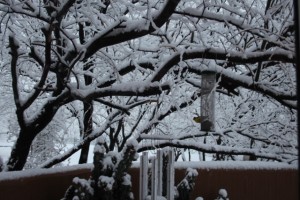
Those of you who live in AZ will understand why the snow storm we just had was a major miracle. If you live in Kansas City, you might not agree this week. But for desert dwellers in the middle of a long drought, water in any form is good news.
More importantly for my wild heart, the snow created a fairyland that made me feel about six. Sitting in my home office, I could feel my wild heart sitting up to take notice. “It’s turning white!” she said, anticipating an adventure.
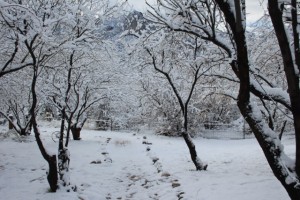
Sure enough, after part one of the storm my husband came home and we put on our boots and went for a walk. Crunching along, halfway around our usual loop, it started to snow again. Slowly at first, then more and more intensely. We started to laugh. Slowly at first, then more and more intensely. Our dog began to prance. We were in the middle of a full-on snow storm.
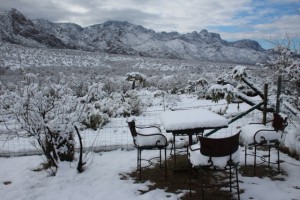
By the time it all ended, our table on the hill was uninhabitable, but my wild heart loved the scene. And here are some of the reasons:
- My wild heart loves surprises.
- My wild heart loves wildness in nature.
- My wild heart loves beauty.
- My wild heart loves transformation.
- My wild heart loves joy.
I got all these in one walk. There’s something to treasure, to consider, to keep.
And you? What does your wild heart love?
Tags: beauty, consciousness, creative imagination, inner landscape, Nature and the soul, perception, Photography, The Beauty Way
Posted in happiness, nature as mirror, Photography, shifting how we see, Tools for seeing ourselves, weather, winter | 5 Comments »
Monday, February 4th, 2013
The second process I’ll use to explore what my wild heart desires is photography. I went on a walk in Catalina State Park, which is a treasure right next to my house. (I know, my wild heart is already grateful.) I took some photos—not thinking too much about why, except I was attracted to that scene—and now I’ll dialogue with them.

Seeing the great Catalinas, touched by the setting sun, I remember that my wild heart’s desire is always to live near beauty, with beauty surrounding me, and to be on the Beauty Path. That is, if for some reason I find myself in a place that doesn’t seem beautiful, I will find beauty there, or create it. Thank you for reminding me of how much I love beauty.
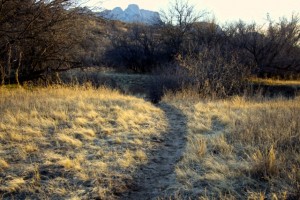
I am reminded that I am always looking for my path. That the exploration–the finding and following my path–is a lovely adventure in itself. My wild heart loves that exploration and isn’t nearly as attached to the destination or the end result as my mind and my ego. Another good reminder!

This scene reminds me that reflections–even in an ordinary rain puddle–can be lovely. The way nature is reflected is a treasure, if we just remember to look. My wild heart loves to find lovely reflections, both in nature and in my own inner landscape. She loves the process of taking time, of looking and remembering to remember. She wants me to always allow time for this.
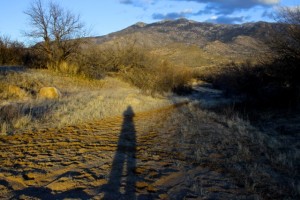
Finally, I stop and see myself–my shadow–in the landscape. What does this show about my wild heart? The photo tells me that my mind and ego tend to think my shadow–the parts of me that aren’t visible to me in “normal life”–show up in natural ways in order to be recognized and accepted. That means the parts of me that aren’t so nice and pretty are going to show up in my outer life through my relationships, and they’ll also show up in my inner landscape. And that is a good thing. My wild heart doesn’t care if I have imperfections. She’s all about discovery, exploration, venturing into uncharted territory. She says we can all have wonderful discoveries when our shadow shows up. Sometimes these involve healing old wounds and other times they involve seeing and recognizing our gifts.
What do these four photographs say to you about your own wild heart? I invite your comments!
Tags: beauty, consciousness, creative imagination, creativity and empowerment, inner landscape, Nature and the soul, perception, Photography, The Beauty Way
Posted in bringing out your gifts, consciousness, Gaia, happiness, healing, Imagination, inner landscape, loving ourselves, nature as mirror, Photography, seeing oneself, shifting how we see, spiritual practices, The Beauty Path, Tools for seeing ourselves | 4 Comments »
Tuesday, October 9th, 2012
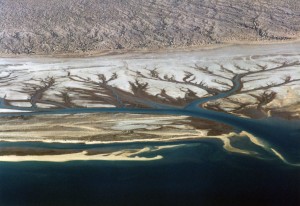
It’s so easy and delicious for me to sink onto a place of beauty in nature and feel safe in that “All Is One” feeling. Next to ocean, or stream, or wind through the pines I am reminded of the life force that courses through all things. I am in my safe landing space at those times.
And then we know there are other moments. Moments that suck. Moments that are almost intolerable. Moments when we don’t want to be here. Moments when we feel like life must be against us. These moments do not feel like safe landing spaces.
So what to do? Especially since those ‘other moments” are when we need a safe landing space the very most.
Well, I say we create beauty. We must.
I love to talk about Victor Frankl, because he is the most extreme example I can come up with of a human who could create beauty out of the most meager ingredients. A concentration camp survivor whose whole family was exterminated, he credited his survival to his decision to find meaning in every day.
If he could do that in those circumstances, surely I can do it in mine.
But how, in those moments of despair, frustration, fear, or anger do we create beauty? There is a lot of ugliness in the world, after all.
I think it’s a choice. About how to see. Without being a Polyanna, without denying, we can choose to see beauty.
I can choose to find the beauty in an ordinary task like peeling a vegetable that God made, or even cleaning a toilet I’m lucky to have. I can choose to find beauty in weeding a garden where I’m making room for new life. I can choose to seek out the beauty that accompanies some of the worst tragedies, where in the midst of great loss there is some moment of exquisite love. I can choose to not be blind, but just to see “through a different lens.”
Maybe this is part of our work on earth. At least it makes our journey here more lovely.
Do it for you. Create beauty just to make your day better.
Do it for someone else. See if that doesn’t make your day better too.
See if when you create beauty, it doesn’t make you feel safe somehow. Safe in the fact that you are a creator. Safe in the fact that there is beauty in the first place. Safe in the fact that creating beauty is a well-worn path. A sacred one. One which has eternity in it.
Ah, now you have landed. In a beautiful place. On solid ground.
Tags: beauty, consciousness, creative imagination, creativity and empowerment, Flying, Flying Lessons: How to Be the Pilot of Your Own Life, Flying metaphor, inner peace, musings, Nature and the soul, perception, Photography, spiritual practice, The Beauty Way
Posted in aviation, coaching, conscious evolution, consciousness, creative imagination, creativity and empowerment, Flying, happiness, healing, Imagination, nature as mirror, Photography, seeing oneself, shifting how we see, spiritual practices, The Beauty Path, Tools for seeing ourselves | 5 Comments »
Tuesday, January 3rd, 2012
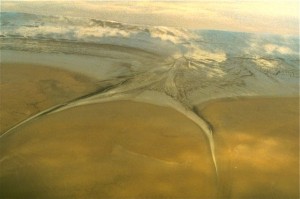
When I walk on the beautiful land in the Sutherland Valley, beneath the Catalina Mountains, the land reminds me that Mother Earth has a heartbeat, a rhythm. Being in nature attunes my body to her rhythm and reminds me of my own natural pace. So does meditation—it is a way of stopping to check in with the Source, and with my own body/mind, and re-calibrating.
I need to change my “attitude,”—an aviation term for the angle of the airplane– to pull the nose of my airplane up a bit and slow my speed.
When I think of the idea of slowing my pace, my “small mind” immediately panics at the thought. What will I miss? What will I not accomplish?
Fortunately my “larger mind” responds by asking, “Where are you going so fast? What is your destination or goal that is so crucial? Isn’t the journey the point?”
My small mind says nothing.
I remember Thich Nhat Hahn’s cautions about our pace, his advice about mindful walking and mindful eating and avoiding multi-tasking.
My small mind points out how many things I accomplish by multi-tasking. Is that really true? Recent research points out that our brains don’t operate at maximum efficiency when we do more than one thing at a time. Maybe we are sacrificing focus, intensity and depth of thought, excellence in problem-solving.
Perhaps I suffer from the aviator’s dreaded plague, “get-there-itis,” the disease that leads to unwise decisions like flying too late, or into bad weather, or when sick, or in conditions outside our expertise. If we crash, we might ask ourselves what was so important about that destination and how much time we really saved.
If I take time to gaze out the window, perhaps I’ll really see something like the scene in the photo of the water and cloud formations along the Sea of Cortez. What’s the hurry, really?
These are thoughts each of us must bring to consciousness as we pilot our way through a year that may challenge us to drop old patterns, to take responsibility for our own energy, to ask treasured family and friends to support us as responsible pilots who have taken the left seat. We may not be able to manage the strong winds of life, but we can manage ourselves.
What are your thoughts? Interact with us at Facebook.com/FlyingLessons!
Tags: Being, consciousness, Flying, Flying metaphor, inner peace, living today, managing change, meditation, musings, Nature and the soul, new life, own pace, Photography, spiritual practice, The Beauty Way
Posted in aviation, Being, coaching, conscious evolution, consciousness, Flying, happiness, healing, health, inner landscape, loving ourselves, managing change, meditation, mindfulness, new life, not doing, nourishing ourselves, Photography, returning to essence, seeing oneself, self-healing, shifting how we see, shifting paradigms, spiritual practices, The Beauty Path, Tools for seeing ourselves | No Comments »
Tuesday, December 13th, 2011
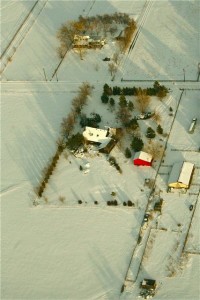
Just because you are reading this, I think you deserve congratulations for taking the time to read something just for you! No matter what your holiday traditions, this is a busy time!
Which is why I ended up reading my own Flying Lesson #2 over again. It’s Bring Enough Fuel for the Journey. Here are some excerpts and thoughts that struck me all over again as good advice for the season:
It’s food for thought that even though there’s no excuse for running out of fuel in the aviation world, we consider running on empty a normal part of our culture. In some circles there’s even a sort of nobility attached to being such a hard worker that everyone knows you never sleep. Even when people refer to someone as being a workaholic, rarely do they shake their heads in sadness or suggest a good treatment center. In many cases, overworking and overdoing is considered the means to success.
But when we have the ambition to fly, to rise above the gravity of our current situation, self-care becomes a crucial function. If we are going to push the envelope and move into a lofty territory where humans have only dreamed of operating we’ll have to pay attention to everything we’re doing and be conscious.
Being conscious is what piloting our lives is all about. And the proof of the pudding (especially the Christmas pudding) is how well we manage our own energy.
Have you ever stopped in the midst of rushing around to listen to a small voice saying something like, “What AM I DOING?”
This is the same voice who might ask other wise questions, like:
- How about a 15-20 minute power nap?
- What if I just took a hot bath instead of…
- Is the food I’m about to eat truly my premium fuel?
- What if I went to bed at 9 tonight?
- Do I really want to go to that party?
- Is this conversation nourishing me?
Never running out of fuel is about taking 100% responsibility for not burning out, not depleting yourself, and for knowing and cultivating the kinds of premium fuel that truly give you energy. Who else will do this for you?
Hmmm, maybe Santa. On the other hand, why not put this present right in the center of your being this minute:
Peace.
Joy.
Freedom to manage your own energy.
May you find the generous heart within that wants to give you these gifts this season.
In love and light,
Pam
Tags: consciousness, Flying, Flying metaphor, holidays, inner landscape, inner peace, living today, managing change, managing energy, managing stress, musings, new life, perception, Photography, spiritual practice, The Beauty Way, winter
Posted in aviation, conscious evolution, consciousness, creativity and empowerment, Flying, health, inner landscape, loving ourselves, new life, nourishing ourselves, Photography, seeing oneself, self-healing, shifting how we see, shifting paradigms, spiritual practices, Tools for seeing ourselves | No Comments »















